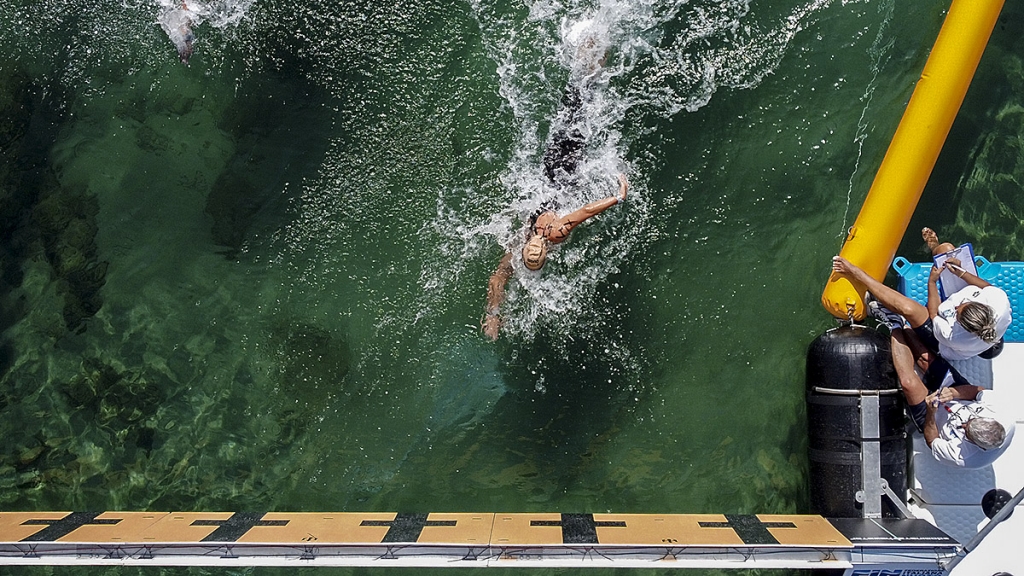British 400 meter runner and Olympic gold medalist Andrew Steele, who now writes about human performance, started an interesting thread on Twitter last week.
After watching on-screen displays of biometric data during a soccer game, he wondered if track & field could benefit from a similar system.
Track and Field needs a new lease of life.
I think we should find new ways to add value to the viewing experience.
Yesterday I asked athletes if they would be happy to share their live biometric data for broadcast, and the response was an overwhelming yes.
🧵A quick thread… https://t.co/HCOZ0KXNrI pic.twitter.com/JaXcGBNDwr
— Andrew Steele (@AndrewSteele) April 14, 2023
Let’s call it the anti-ISL. The ISL was founded under the belief that times were too confusing, and that viewers should get as little data as is possible. That, of course, belied the trends we see in literally every spectator sport, where more-and-more data has become an integral part of the presentation.
ISL’s belief that “post-modern” was a reversion to “the beauty of the sport,” rather than a progression to “a beautiful mind.”
Organizers eventually relented, showing not only times, but also live in-race pacing.
This got my wheels turning about how swimming could incorporate biometric data into its presentation.
Besides just being absolutely fascinating, it could be a fantastic way to engage viewers throughout a race – it’s certainly at least as interesting as spending the first 50 meters talking about reaction times.
Where this data really has the opportunity, in my opinion, to revolutionize swimming (and track & field) are in the middle-distance and distance races.
I don’t think I’m saying anything too controversial to point out that the overwhelming majority of fans prefer to watch swimming sprints rather than 1500 frees, or even moreso, open water races.
The sprints are clear. They’re compact. They’re competitive.
But distance races? A 2 hour 10k? They’re long races with a whole lot of filler on the way to a sometimes furious, and sometimes lopsided, last 10 meters.
But what if we could watch a race and see that swimmer A may be out-splitting swimmer B, but swimmer B’s heart rate is 15 bpm lower than swimmer A? Imagine the tension that would be built if there are biometric indicators that the leading swimmer might be working harder than the guy who is chasing him.
Especially in open water races, where the events are so tactical, this could turn the event into a can’t-miss viewing experience.
World Aquatics (formerly known as FINA) recently changed rules allowing swimmers to wear technology during a race, and technology is increasingly becoming a part of high-level swim training, so the infrastructure is there.
What do you think? Would you let your biometric data show during a race? Would you be interested in seeing this during a race?
Answer via the poll below, and elaborate in the comments. Try and select the category that best captures your interest in swimming at a major meet.

actually would be sick
What kind of biometric data are we talking about for swimmers? Just heart rate? SPo2? Something else?
As a swimmer, I’m entirely ambivalent. From my decades swimming and coaching, I’ve seen substantial variability in heart rates among swimmers at a given pace, even when they’re similar swimmers, so seeing that swimmer A has a 147 HR at the midpoint of their 400 while swimmer B has a 165 HR is effectively meaningless data.
On the flip side, as a coach, I’d love to see that data for my swimmers since I’d know their baselines. The actionable data I’d like to see for my swimmers would be HR, DPS, and velocity. Whether there are wearables that can accurately track those stats… Read more »
If the swimmers has access to the other swimmers’ biometric data during a race, now that could spice up distance swimming.
Sprints are actually not the best races to watch, the mid-distance ones are. 100s, 200s, 4IM, that where the exciting swimming is.
How would that possibly work? Computer goggles that display data on other swimmers during the race?
Also I don’t know anyone who considers a 100 to be “mid distance”
Not an OlympicGold medallist.
The only thing I have against using biometric stats is their accuracy, firstly with the monitors and secondly with how much heart rate reflects effort put in. From my extremely limited experience with admittedly cheap heart rate monitors, I’ve found their readings to be wildly inconsistent and also only weakly correlated to actual effort put in, being wrong in both directions at different times.
This is all based off of some very limited experience, so I could be entirely in the wrong. Assuming it is the case that I’m wrong, then I think it would be awesome. I agree wholeheartedly that flooding broadcasts with numbers and live analysis would make the distance swimming way more fun to watch. As… Read more »
There’s many cool stats to track, would be cool to know.
Doesn’t mean that we should track all of these stats, the information may be too much.
Maybe introduce this slowly to minor competitions.
Some people may care, others not.
I love the potential but swimming broadcasts also need to focus on better working of camera angles and production quality. The world record lines could be improved, there could be efforts to highlight what swimmers is in what lane during the race, and allowing a larger budget for announcing should come before trying to implement live heart rate data. I’d love to see the data but I also have a feeling that the first iterations could end up wildly inaccurate and be more frustrating than appealing.